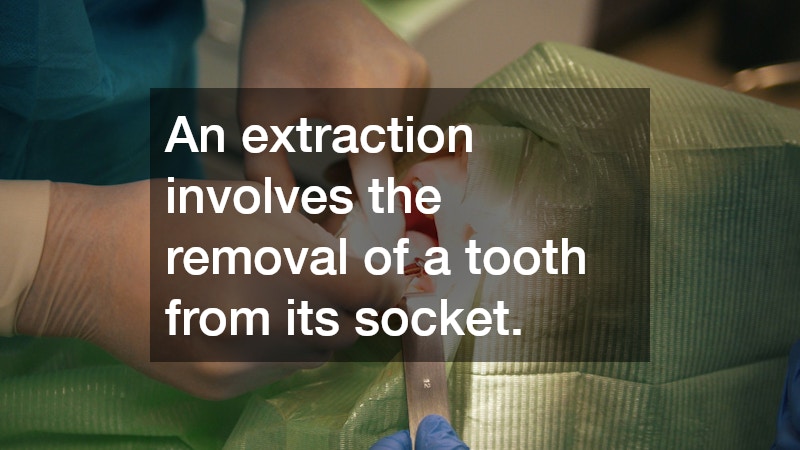
When Is a Dental Extraction Necessary?
When Is a Dental Extraction Necessary?
Dental extractions are sometimes necessary to preserve your overall oral health and prevent more serious problems. An extraction involves the removal of a tooth from its socket, usually when it can no longer be repaired through other restorative treatments. While dentists strive to save natural teeth whenever possible, there are times when removal is the healthiest option. This article explains the most common reasons for extractions, the role of infection, possible alternatives, and what patients should know about preparation and recovery.
What Are the Common Reasons for Dental Extractions?
Severe Tooth Decay
When decay reaches the inner pulp of the tooth and damages the nerve beyond repair, extraction may be required. If a filling or root canal cannot save the tooth, removal prevents the infection from spreading to nearby teeth or bone.
Gum Disease
Advanced gum disease, also known as periodontitis, can cause the supporting bone and tissue around teeth to weaken. When teeth become loose and unstable, extraction may be necessary to protect the surrounding oral structures.
Tooth Damage Due to Trauma
Severe fractures or breaks from accidents, sports injuries, or grinding can make a tooth unsalvageable. If the damage extends below the gumline, extraction is often the only solution to prevent infection or pain.
Overcrowding and Orthodontics
In some orthodontic cases, removing one or more teeth creates the space needed to align the bite properly. Extractions help reduce overcrowding and allow braces or aligners to shift teeth efficiently.
Impacted Teeth (Including Wisdom Teeth)
Impacted teeth are trapped beneath the gum or bone and cannot emerge properly. Wisdom teeth are the most common culprits. When they cause pain, swelling, or crowding, extraction prevents complications such as infection or cyst formation.
How Does Infection Influence the Need for Extraction?
Signs of Dental Infection
Symptoms of infection include throbbing pain, swelling, fever, and sensitivity to heat or pressure. These indicate bacteria have reached the tooth pulp or surrounding bone.
Spread of Infection and Health Risks
If untreated, infection can spread to nearby tissues, the jawbone, and even the bloodstream. In rare cases, this can cause systemic conditions that threaten overall health.
Antibiotic Treatment vs. Extraction
While antibiotics may control minor infections temporarily, they cannot cure infections inside a tooth. When decay or bacteria reach deep tissue, extraction or root canal therapy is necessary to remove the source of infection.
Preventing Post-Extraction Infection
After an extraction, following your dentist’s aftercare instructions is crucial. Keeping the area clean, avoiding smoking, and maintaining gentle oral hygiene help promote healing and reduce infection risk.
Long-Term Health Implications of Untreated Infections
Ignoring a dental infection can lead to chronic inflammation, bone loss, or abscess formation. Prompt extraction when needed protects both oral and systemic health.
What Are the Alternatives to Tooth Extraction?
Dental Fillings and Crowns
For smaller cavities or structural damage, fillings or crowns can restore and protect teeth from further decay without the need for removal.
Root Canal Therapy
A root canal removes infected pulp while preserving the natural tooth. It’s often the preferred alternative when infection is confined to one tooth.
Periodontal Treatments
Scaling, root planing, and gum therapies can stabilize teeth affected by gum disease and reduce the need for extraction.
Orthodontic Solutions
In cases of crowding, orthodontic expansion or tooth reshaping can sometimes create enough space to avoid extractions.
Monitoring and Maintenance Strategies
For minor issues, careful monitoring combined with improved oral hygiene and regular dental visits can slow or halt progression, delaying or eliminating the need for removal.
Are There Risks or Complications Associated with Extractions?
Typical Post-Extraction Symptoms
Mild bleeding, swelling, and soreness are normal after extraction and usually subside within a few days. Following proper aftercare helps minimize discomfort.
Dry Socket and How to Avoid It
A dry socket occurs when the protective blood clot dislodges, exposing bone and nerves. Avoid drinking through straws, smoking, or vigorous rinsing during the first 24 hours to prevent it.
Potential Nerve Damage
While rare, nerve injury can occur during complex extractions, particularly with impacted wisdom teeth. Choosing an experienced dentist or oral surgeon reduces this risk.
Bleeding and Swelling
Applying gentle pressure with gauze and using cold compresses can manage normal post-procedure bleeding and swelling. Persistent issues should be reported to your dentist.
Managing Pain and Recovery
Over-the-counter pain relievers and prescribed medications help manage discomfort. Eating soft foods, keeping the site clean, and resting promote faster healing.
How to Prepare for a Tooth Extraction?
Initial Consultation and Evaluation
Your dentist will review your medical history, take X-rays, and discuss treatment options. This step ensures a safe procedure tailored to your needs.
Dietary Restrictions Before and After Surgery
Patients should avoid eating or drinking immediately before a surgical extraction if sedation is used. After treatment, soft foods and plenty of fluids are recommended until healing progresses.
Understanding the Procedure
The dentist numbs the area with local anesthesia before loosening and removing the tooth. In surgical extractions, small incisions may be made for better access.
Post-Operative Care Instructions
Keep the extraction site clean by gently rinsing after 24 hours and brushing carefully. Avoid smoking and heavy exertion for a few days. Follow any medication and follow-up instructions closely.
Scheduling Follow-Up Appointments
A follow-up visit allows your dentist to monitor healing and discuss tooth replacement options, such as bridges, implants, or dentures, if needed.
Dental extractions are sometimes unavoidable but are always performed to protect your health and prevent further complications. Whether caused by decay, trauma, or infection, timely treatment preserves oral function and comfort. By understanding when extractions are necessary, exploring alternatives, and following post-care guidelines, you can maintain a healthy, balanced smile for years to come.



